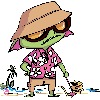HOME | DD
 Dedasaur — How to paint a ship (tutorial)
Dedasaur — How to paint a ship (tutorial)
Published: 2013-03-23 15:17:59 +0000 UTC; Views: 1161; Favourites: 4; Downloads: 0
Redirect to original
Description
I was asked to show more of the layers and the brushes so I made a second walk through with the current special.I work mainly in layers because that's how I would do it traditionally, work from the bottom up - my preferred medium being gouache and glaze for this kind of style.
I put the sketch on top and set the layer on multiply.
Create the panels with the object tool and then create a selection.
I dump the base color with the bucket and turn down the sketch opacity.
Now I pick a dry brush and start painting on sperate layers the other colors. Like this, if I want to turn the opacity down I still can, and if I want to play with multiply... I also can.
Then I take a regular hard brush and do the linework. This is not pure white though. I never use pure white and pure black as they actually do not exist in nature and make things look... mhhh... artificial, I'd say...
Now I group my background layers in a folder and I start drawing the characters. One or two layer for every color. I chose my yellow to be my middle layer. All the other colors will actually go on top or below... or both.
The layers you see on top are from the previous page. Although I write down the code numbers of my colors... sometimes, to make sure I am keeping consistency, I create my new page in the same file as the old one where I swtich on and off the old layers and double check comparing with the new ones... before I trash the old ones away.
As you see my skin tone is both on top and bottom. The bottom one allows me to fill empty shapes fast. the top one is to refine the edges with the yellow border so... for touch ups.
I do the same for all the other colors... Beige.
Dark blue.
Red and ochre.
Browns and blues.
Then I create a layer to do my brown linework which will help give solid form to the figure. When I do the linework I usually fix the shape of the fill too. So naming the layers help me find things fast.
I don't know what this brush is called. I customized it long ago from an airbrush in Cs5 and I cannot replicate it in Cs6, but it's my favorite brush and I definitely need to save and export my favorite brushes if I ever want to switch to cs6 (which might not happen though because I find it heavy).
I pick my brown from the base and create a layer that I set on multiply and then I turn the opacity down. Like this I do my shadows.
Done.
I flatten the artwork, save the file as Lettering and do my lettering .
Related content
Comments: 4

Grande, grande, grande...Solo poche domandine però...
Le cartelle servono per raggruppare layer de background o dei personaggi, serve per lavorare meglio (per cercare subito quello che ti serve) o ha altri scopi?
Per le ombre crei altri layer oppure usi, per esempio layer colore tendaggi e lì faccio le ombre (per curiosità perchè alla fine hai davvero tanti livelli!)
Non so se ho capito benissimo come funziona la storia dei livelli sopra e sotto rispetto a quello di mezzo. Se la linea sta nel mezzo e metto due layer colore giallo, uno sopra e uno sotto, in quello sopra il colore può andare sopra la linea e coprirla, in quello sotto è il ocntrario. E' come dire in 3D un oggetto sta avanti un altro o ne è coperto. Ho capito bene?
Interessante il fatto di usare prima il colore e dopo marcare le linee dei personaggi, in genere vedo sempre il contrario.
Grazie mille per il tutorial
Chiya
👍: 0 ⏩: 1

Le cartelle mi servono quando ho tanto livelli, se voglio accendere e spegnere i livelli... per vedere se ho buchi nei colori, è più facile spegnere una cartella piuttosto che 5 o 6 livelli.
Le ombre sono su un livello solo, uso lo stesso colore per tutte le ombre, di solito il colore delel ombre dipende dal colore della luce.
In questo speciale siamo quasi sempre di notte, la luce è azzurrina allora ho optato per il marrone come ombra.
Hai capito bene... quello sotto sta dietro la linea e mi serve per riempire spazi grandi (tanto le sbavature vanno dietro al colore soprastante e non si vedono), quello sopra ci faccio i ritocchini piccini picciò.
Di norma anche io parto sempre dalle linee e poi coloro.
Ma quando disegno in vettoriale o piatto mi serve vedere le silhouette e la forma degli oggetti.
Se avessi le linee prima avrei forme tutte sbavate o troppo dipendenti dal tratto - mi serve che le forme siano forti e si vedano anche senza il tratto.
👍: 0 ⏩: 1

Sei stata chiarissima grazie, grazie, grazie!
Chiya
👍: 0 ⏩: 0


